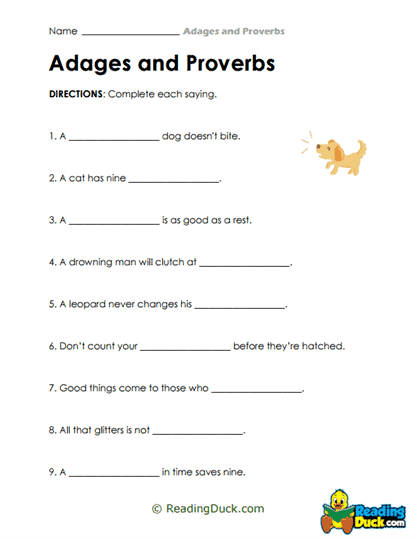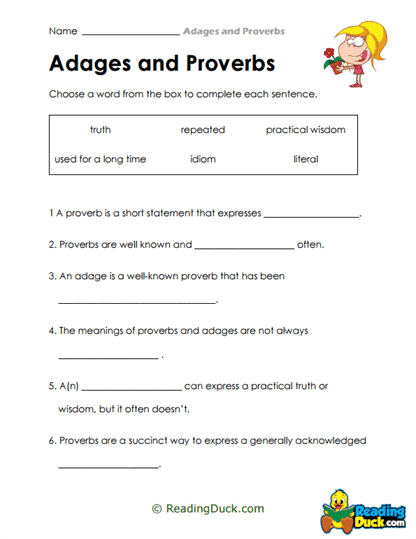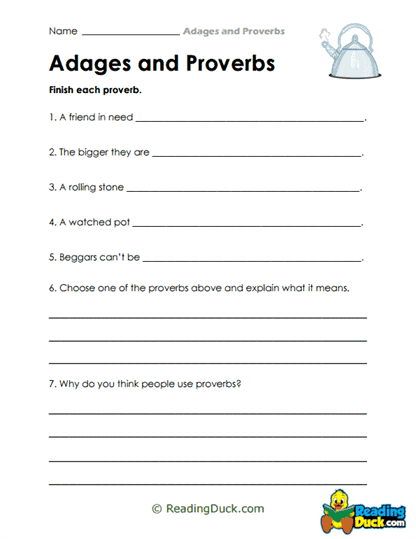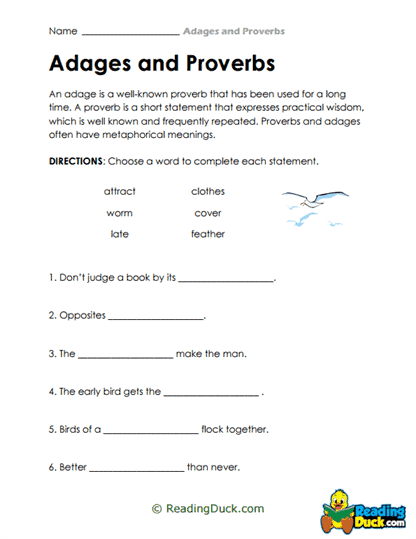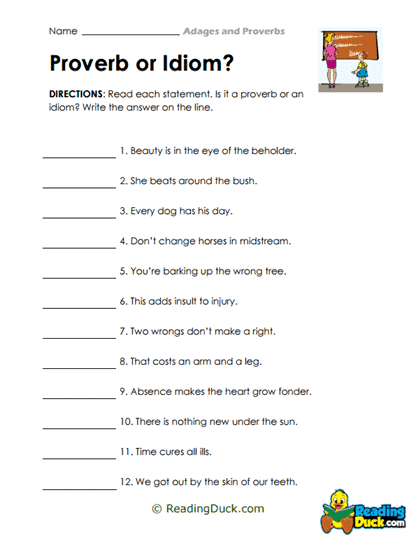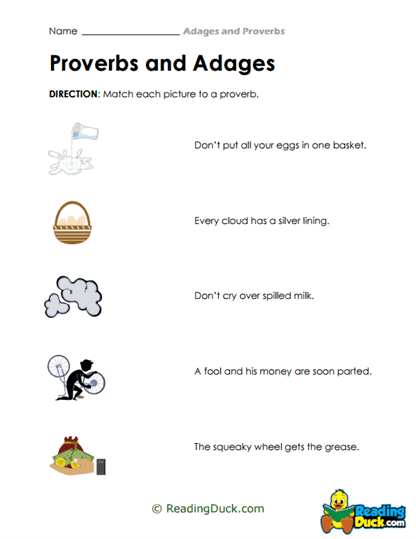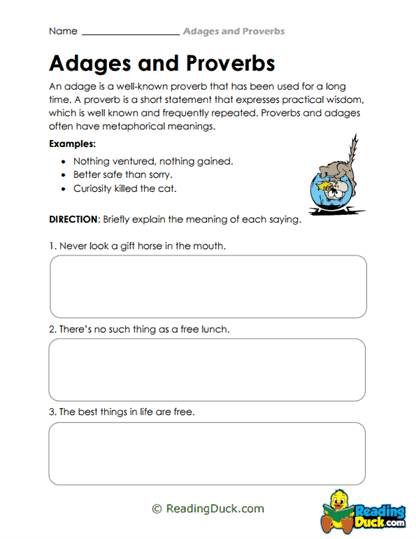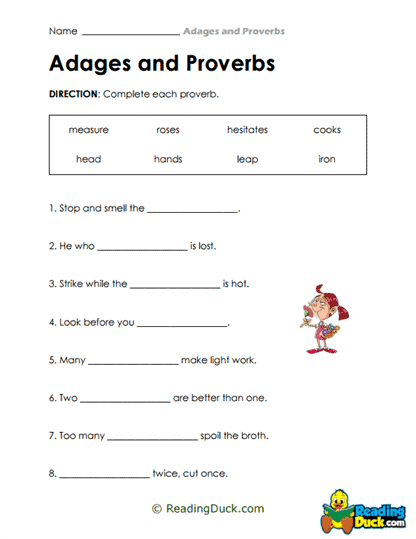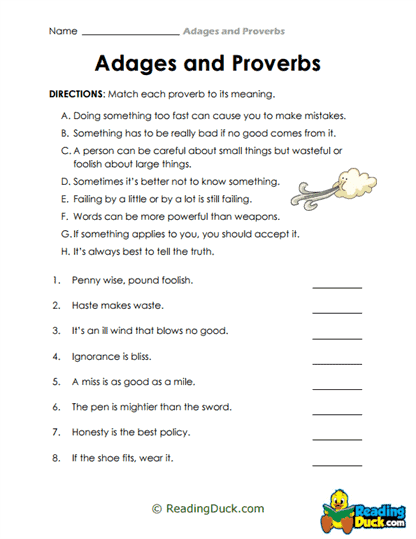Adages and Proverbs Worksheets
About Our Adages and Proverbs Worksheets
Our collection of Adages and Proverbs Worksheets is a key resource under the Language category in the Skills section. This collection is designed to help students develop a deeper understanding of language, culture, and communication through the exploration of adages and proverbs. These worksheets guide students in recognizing the wisdom and cultural values embedded in these short, traditional sayings. By working through these activities, students gain valuable insights into the power of concise language, while also improving their critical thinking and interpretative skills.
The worksheets are presented in PDF format, making them easy to view, download, and print for convenience. Each worksheet also includes a downloadable answer key, providing educators and students with a streamlined method for checking progress and understanding the material.
Understanding Adages and Proverbs
Adages and proverbs are short, commonly used expressions that convey truths or pieces of wisdom based on cultural experiences. These sayings are passed down through generations, often rooted in common sense or universal truths. Despite their brevity, they carry profound meanings and are often used in both formal and informal communication.
Adages: Adages are well-known, traditional sayings that express universal truths or observations about life. They are often metaphorical and have been used for centuries to impart wisdom.
-
- Example: "A stitch in time saves nine" is an adage that suggests taking early action to fix a problem before it worsens.
Proverbs: Proverbs are short, wise sayings that offer advice or express a generally accepted truth. Like adages, they are usually passed down through cultures and societies, often reflecting shared values.
-
- Example: "Actions speak louder than words" is a proverb advising that what people do is more important than what they say.
Why They Matter:
- Both adages and proverbs help us understand the values, morals, and experiences of different cultures. They distill complex ideas into simple phrases, making wisdom more accessible. In language education, they serve as excellent tools for teaching figurative language, abstract thinking, and cultural literacy.
Common Examples of Adages and Proverbs:
- "Better late than never" (It’s better to do something late than not at all)
- "The early bird catches the worm" (Those who act quickly or arrive early are more likely to succeed)
- "Don’t count your chickens before they hatch" (Don’t assume success until it happens)
The Unique Characteristics of Adages and Proverbs
Adages and proverbs stand out because of their succinctness, memorability, and cultural significance. Their concise wording often relies on metaphorical language, making them both easy to remember and impactful. Unlike long-winded explanations, adages and proverbs communicate wisdom in just a few words, encouraging reflection and deeper thought.
Historical Context:
Adages and proverbs have been around for thousands of years, with many stemming from ancient cultures. Some of the earliest known examples come from Ancient Greece, Rome, and China, where these sayings were used to teach moral lessons and pass down collective wisdom. For example, Confucius, the famous Chinese philosopher, was known for his proverbs that continue to be quoted today. Over time, adages and proverbs spread across societies, evolving to reflect local customs, values, and beliefs.
Defining Characteristics:
- Brevity: These sayings are brief, usually consisting of a single sentence, which makes them memorable.
- Universal Truth: They express ideas or advice that hold relevance across time and cultures.
- Cultural Insight: Adages and proverbs often reveal the morals, ethics, and values of the society from which they originate.
- Metaphorical Language: These expressions frequently use figurative language, requiring readers or listeners to interpret the deeper meaning behind the words.
Examples from Different Cultures:
- English: "A penny saved is a penny earned" (Be wise with your money and it will grow)
- Chinese: "A journey of a thousand miles begins with a single step" (Every big accomplishment starts with a small action)
- Spanish: "El que madruga, Dios le ayuda" ("God helps those who wake up early" – Similar to "The early bird catches the worm")
The Role of Adages and Proverbs in Literacy Skills
Learning adages and proverbs plays a significant role in the development of students' literacy skills. These sayings encourage critical thinking, as students must often interpret the figurative language and apply the underlying wisdom to real-life situations. This process strengthens reading comprehension, as students learn to move beyond literal meanings to grasp deeper, more abstract ideas.
Furthermore, students who are familiar with adages and proverbs improve their writing and speaking skills. The ability to incorporate these sayings into their communication allows them to express ideas more creatively and persuasively. Proverbs, in particular, add richness to language, allowing students to connect their thoughts to widely understood concepts. This enhances their fluency, making them more effective communicators, both in academic contexts and everyday life.
Adages and proverbs also serve as a bridge to understanding cultural texts, literature, and historical writings. Many classical works of literature and speeches incorporate these expressions, and students who recognize and understand them are better equipped to analyze and appreciate these texts.
Engaging Activities for Reinforcing Adages and Proverbs
Educators can reinforce the learning of adages and proverbs through interactive activities that encourage both understanding and creative use of these expressions. These activities can be adapted for different educational settings, including traditional classrooms and homeschool environments.
- Proverb Matching Game (Grades 3-5): Create cards with the first half of a proverb on one set and the second half on another. Students must match the halves to form complete proverbs. This game helps familiarize students with common proverbs and their meanings.
- Adage Illustration Project (Grades 4-6): Have students choose an adage or proverb and create an illustration that depicts its meaning. This project allows students to engage with the figurative language of the saying and express their understanding creatively.
- Proverb Storytelling (Grades 5-7): In this activity, students are asked to write a short story or scenario based on a selected proverb or adage. This helps them apply the wisdom of the saying in a narrative format, reinforcing its meaning through storytelling.
- Cultural Proverb Research (Grades 6-8): Assign students to research proverbs from different cultures and present their findings to the class. This activity not only helps with understanding language but also promotes cultural literacy.
- Role Play Proverbs (Grades 3-5): Students can act out different scenarios where a proverb applies. For example, they could role-play a situation where "Don’t put all your eggs in one basket" would serve as helpful advice. This makes learning fun and encourages students to think critically about the real-life applications of these sayings.
These activities engage students in both creative and critical thinking, allowing them to explore the meanings behind adages and proverbs while developing essential language skills.
The Practical Importance of Learning Adages and Proverbs
The ability to understand and use adages and proverbs is a valuable language skill that has real-life applications in communication, reading, and writing. These sayings are not only part of everyday conversations but are also found in literature, speeches, and media. Students who master adages and proverbs can communicate more effectively, drawing on the wisdom and shared cultural knowledge that these expressions provide.
In professional settings, adages and proverbs can be used to convey ideas succinctly and persuasively, making them an important tool in rhetoric and public speaking. Moreover, understanding the cultural nuances behind these sayings can deepen students’ empathy and global awareness, as they reflect on the values and experiences of different societies.
In summary, the study of adages and proverbs is more than just memorizing sayings—it is about understanding the richness of language and its power to convey universal truths. Through these worksheets, students gain not only linguistic skills but also valuable life lessons that transcend the classroom.
